Satellite Imagery for Rapid Detection of Liquefaction Surface Manifestations: The Case Study of Türkiye–Syria 2023 Earthquakes
Abstract
:1. Introduction
1.1. The 6 February 2023 Türkiye/Syria Earthquake Doublet
1.2. Geological Setting
2. Materials and Methods
2.1. Data
2.1.1. Optical Satellite Imagery
2.1.2. SAR Satellite Imagery
2.1.3. Other Sources
2.2. Methodology
2.2.1. Selection of Inspection Area
2.2.2. InSAR Analysis
2.2.3. Visual Mapping
3. Results
3.1. Spatial Distribution of Liquefaction Manifestations
3.2. Correlating the Distance of Liquefaction Sites with Location of Epicenters and the Fault Rupture
4. Discussion
4.1. Correlating the Spatial Distribution of Liquefaction Phenomena with the Seismic Parameters and the Geomorphology
4.2. Recurrent Liquefaction in Antakya
5. Conclusions
- (1)
- High and very high-resolution optical satellite imagery, with the aid of radar satellite imagery and interferometry, enabled us to rapidly acquire a thorough map of liquefaction manifestations and sites across a large area affected by the two strong earthquakes.
- (2)
- Despite the limitations of the current mapping data and results, we consider this map an almost complete documentation of liquefaction site distribution across the affected area in SE Turkey and Syria. Most areas with significant concentration and severe magnitude of liquefaction phenomena are also described.
- (3)
- Application of the proposed workflow for mapping liquefaction with remote sensing data successfully limited the search focus for this study and enabled rapid mapping through a vast area.
- (4)
- The majority of liquefaction phenomena were found along meandering sections of river valleys, coastal plains with fine sediments, drained lakes and swamps, and lacustrine basins along the East Anatolian Fault. In addition, it is crucial to highlight the very high liquefaction susceptibility of reclaimed lands as it has been confirmed in the case of the city of Iskenderum and Hatay airport. These areas are suggested to be studied in detail in order to decrease the liquefaction potential of the subsoil layers and consequently minimize the relevant risk to the manmade environment.
- (5)
- Results confirm once again the major correlation between geomorphology/surficial geology and liquefaction manifestation of strong earthquakes. These geomorphological conditions can serve as a successful proxy of local site investigations at a regional scale and can drive future investigations and focus areas of interest for future liquefaction hazard mapping.
Supplementary Materials
Author Contributions
Funding
Data Availability Statement
Conflicts of Interest
References
- Leeder, M.R. Soft sediment deformation structures. In Sedimentology: Process and Product; Springer: Dordrecht, Netherlands, 1982; pp. 111–116. [Google Scholar]
- Seed, H.B. Soil liquefaction and cyclic mobility evaluation for level ground during earthquakes. J. Geotech. Eng. Div. 1979, 105, 201–255. [Google Scholar] [CrossRef]
- Youd, T.L.; Idriss, I.M. Liquefaction resistance of soils: Summary report from the 1996 NCEER and 1998 NCEER/NSF workshops on evaluation of liquefaction resistance of soils. J. Geotech. Geoenviron. Eng. 2001, 127, 297–313. [Google Scholar] [CrossRef]
- Cubrinovski, M.; Hughes, M.; O’Rourke, T. Impacts of liquefaction on the potable water system of Christchurch in the 2010–2011 Canterbury (NZ) earthquakes. J. Water Supply Res. Technol. AQUA 2014, 63, 95–105. [Google Scholar] [CrossRef]
- Van Ballegooy, S.; Malan, P.; Lacrosse, V.; Jacka, M.; Cubrinovski, M.; Bray, J.; O’Rourke, T.; Crawford, S.; Cowan, H. Assessment of liquefaction-induced land damage for residential Christchurch. Earthq. Spectra 2014, 30, 31–55. [Google Scholar] [CrossRef]
- Group, E.W. Liquefaction phenomena associated with the Emilia earthquake sequence of May–June 2012 (Northern Italy). Nat. Hazards Earth Syst. Sci. 2013, 13, 935–947. [Google Scholar] [CrossRef]
- Dolce, M.; Di Bucci, D. National Civil Protection Organization and technical activities in the 2012 Emilia earthquakes (Italy). Bull. Earthq. Eng. 2014, 12, 2231–2253. [Google Scholar] [CrossRef]
- Oommen, T.; Baise, L.G.; Vogel, R. Validation and application of empirical liquefaction models. J. Geotech. Geoenviron. Eng. 2010, 136, 1618–1633. [Google Scholar] [CrossRef]
- Oommen, T.; Baise, L.; Gens, R.; Prakash, A.; Gupta, R. Application of Satellite Data for Post-Liquefaction Reconnaissance, Report; Collaborative Research with Tufts University and University of Alaska Fairbanks: Fairbanks, AK, USA, 2011. [Google Scholar]
- Rathje, E.M.; Adams, B.J. The role of remote sensing in earthquake science and engineering: Opportunities and challenges. Earthq. Spectra 2008, 24, 471–492. [Google Scholar] [CrossRef]
- Oommen, T.; Baise, L.G.; Gens, R.; Prakash, A.; Gupta, R.P. Documenting earthquake-induced liquefaction using satellite remote sensing image transformations. Environ. Eng. Geosci. 2013, 19, 303–318. [Google Scholar] [CrossRef]
- Papathanassiou, G.; Valkaniotis, S.; Ganas, A.; Stampolidis, A.; Rapti, D.; Caputo, R. Floodplain evolution and its influence on liquefaction clustering: The case study of March 2021 Thessaly, Greece, seismic sequence. Eng. Geol. 2022, 298, 106542. [Google Scholar] [CrossRef]
- Rathje, E.M.; Franke, K. Remote sensing for geotechnical earthquake reconnaissance. Soil Dyn. Earthq. Eng. 2016, 91, 304–316. [Google Scholar] [CrossRef]
- Ghosh, S.; Huyck, C.K.; Greene, M.; Gill, S.P.; Bevington, J.; Svekla, W.; DesRoches, R.; Eguchi, R.T. Crowdsourcing for rapid damage assessment: The global earth observation catastrophe assessment network (GEO-CAN). Earthq. Spectra 2011, 27, 179–198. [Google Scholar] [CrossRef]
- Ishitsuka, K.; Tsuji, T.; Matsuoka, T. Detection and mapping of soil liquefaction in the 2011 Tohoku earthquake using SAR interferometry. Earth Planets Space 2013, 64, 1267–1276. [Google Scholar] [CrossRef]
- Atzori, S.; Tolomei, C.; Antonioli, A.; Merryman Boncori, J.P.; Bannister, S.; Trasatti, E.; Pasquali, P.; Salvi, S. The 2010–2011 Canterbury, New Zealand, seismic sequence: Multiple source analysis from InSAR data and modeling. J. Geophys. Res. Solid Earth 2012, 117. [Google Scholar] [CrossRef]
- Barnhart, W.D.; Yeck, W.L.; McNamara, D.E. Induced earthquake and liquefaction hazards in Oklahoma, USA: Constraints from InSAR. Remote Sens. Environ. 2018, 218, 1–12. [Google Scholar] [CrossRef]
- Ramakrishnan, D.; Mohanty, K.K.; Nayak, S.R.; Chandran, R.V. Mapping the liquefaction induced soil moisture changes using remote sensing technique: An attempt to map the earthquake induced liquefaction around Bhuj, Gujarat, India. Geotech. Geol. Eng. 2006, 24, 1581–1602. [Google Scholar] [CrossRef]
- Lu, C.-H.; Ni, C.-F.; Chang, C.-P.; Yen, J.-Y.; Chuang, R. Coherence Difference Analysis of Sentinel-1 SAR Interferogram to Identify Earthquake-Induced Disasters in Urban Areas. Remote Sens. 2018, 10, 1318. [Google Scholar] [CrossRef]
- Baik, H.; Son, Y.S.; Kim, K.E. Detection of Liquefaction Phenomena from the 2017 Pohang (Korea) Earthquake Using Remote Sensing Data. Remote Sens. 2019, 11, 2184. [Google Scholar] [CrossRef]
- Youd, T.; Perkins, D. Mapping Liquefaction-Induced Ground Failure Potential. ASCE J. Geotech. Eng. Div. 1978, 104, 433–446. [Google Scholar] [CrossRef]
- Wotherspoon, L.M.; Pender, M.J.; Orense, R.P. Relationship between observed liquefaction at Kaiapoi following the 2010 Darfield earthquake and former channels of the Waimakariri River. Eng. Geol. 2012, 125, 45–55. [Google Scholar] [CrossRef]
- Di Manna, P.; Guerrieri, L.; Piccardi, L.; Vittori, E.; Castaldini, D.; Berlusconi, A.; Bonadeo, L.; Comerci, V.; Ferrario, F.; Gambillara, R.; et al. Ground effects induced by the 2012 seismic sequence in Emilia: Implications for seismic hazard assessment in the Po Plain. Ann. Geophys. 2012, 55, 697–703. [Google Scholar] [CrossRef]
- Bastin, S.H.; Quigley, M.C.; Bassett, K. Paleoliquefaction in Christchurch, New Zealand. Geol. Soc. Am. Bull. 2015, 127, 1348–1365. [Google Scholar] [CrossRef]
- Bastin, S.; Stringer, M.E.; Green, R.A.; Wotherspoon, L.; van Ballegooy, S.; Cox, B.R.; Osuchowski, A. Geomorphological Controls on the Distribution of Liquefaction in Blenheim, New Zealand, during the 2016 Mw7.8 Kaikōura Earthquake. In Geotechnical Earthquake Engineering and Soil Dynamics V; American Society of Civil Engineers: Reston, VA, USA, 2018; pp. 264–272. [Google Scholar] [CrossRef]
- Bastin, S.; van Ballegooy, S.; Mellsop, N.; Wotherspoon, L. Liquefaction case histories from the 1987 Edgecumbe earthquake, New Zealand—Insights from an extensive CPT dataset and paleo-liquefaction trenching. Eng. Geol. 2020, 271, 105404. [Google Scholar] [CrossRef]
- Papathanassiou, G.; Caputo, R.; Rapti-Caputo, D. Liquefaction phenomena along the paleo-Reno River caused by the May 20, 2012, Emilia (northern Italy) earthquake. Ann. Geophys. 2012, 55. [Google Scholar] [CrossRef]
- Papathanassiou, G.; Mantovani, A.; Tarabusi, G.; Rapti, D.; Caputo, R. Assessment of liquefaction potential for two liquefaction prone areas considering the May 20, 2012 Emilia (Italy) earthquake. Eng. Geol. 2015, 189, 1–16. [Google Scholar] [CrossRef]
- Civico, R.; Brunori, C.A.; De Martini, P.M.; Pucci, S.; Cinti, F.R.; Pantosti, D. Liquefaction susceptibility assessment in fluvial plains using airborne lidar: The case of the 2012 Emilia earthquake sequence area (Italy). Nat. Hazards Earth Syst. Sci. 2015, 15, 2473–2483. [Google Scholar] [CrossRef]
- Reilinger, R.; McClusky, S.; Vernant, P.; Lawrence, S.; Ergintav, S.; Cakmak, R.; Ozener, H.; Kadirov, F.; Guliev, I.; Stepanyan, R.; et al. GPS constraints on continental deformation in the Africa-Arabia-Eurasia continental collision zone and implications for the dynamics of plate interactions. J. Geophys. Res. Solid Earth 2006, 111. [Google Scholar] [CrossRef]
- Ambraseys, N.N.; Finkel, C. The Seismicity of Turkey and Adjacent Areas. A Historical Review, 1500–1800; Eren Yayincilik: Istanbul, Türkiye, 1995. [Google Scholar]
- Ambraseys, N. Earthquakes in the Mediterranean and Middle East: A Multidisciplinary Study of Seismicity up to 1900; Cambridge University Press: Cambridge, UK, 2009; Volume 947. [Google Scholar] [CrossRef]
- Guidoboni, E.; Comastri, A.; Traina, G.; Geofisica, I.N.D. Catalogue of Ancient Earthquakes in the Mediterranean Area up to the 10th Century; Istituto Nazionale di Geofisica: Roma-SGA, Bologna, 1994. [Google Scholar]
- Guidoboni, E.; Comastri, A. Catalogue of Earthquakes and Tsunamis in the Mediterranean Area from the 11th to the 15th Century; Istituto Nazionale di Geofisica: Roma-SGA, Bologna, 2005. [Google Scholar]
- Guidoboni, E.; Ferrari, G.; Tarabusi, G.; Sgattoni, G.; Comastri, A.; Mariotti, D.; Ciuccarelli, C.; Bianchi, M.G.; Valensise, G. CFTI5Med, the new release of the catalogue of strong earthquakes in Italy and in the Mediterranean area. Sci. Data 2019, 6, 80. [Google Scholar] [CrossRef]
- Tan, O.; Pabuçcu, Z.; Tapırdamaz, M.C.; İnan, S.; Ergintav, S.; Eyidoğan, H.; Aksoy, E.; Kuluöztürk, F. Aftershock study and seismotectonic implications of the 8 March 2010 Kovancılar (Elazığ, Turkey) earthquake (MW = 6.1). Geophys. Res. Lett. 2011, 38. [Google Scholar] [CrossRef]
- Konca, A.Ö.; Karabulut, H.; Güvercin, S.E.; Eskiköy, F.; Özarpacı, S.; Özdemir, A.; Floyd, M.; Ergintav, S.; Doǧan, U. From Interseismic Deformation with Near-Repeating Earthquakes to Co-Seismic Rupture: A Unified View of the 2020 Mw 6.8 Sivrice (Elazığ) Eastern Turkey Earthquake. J. Geophys. Res. 2021, 126, e2021JB021830. [Google Scholar] [CrossRef]
- Melgar, D.; Ganas, A.; Taymaz, T.; Valkaniotis, S.; Crowell, B.W.; Kapetanidis, V.; Tsironi, V.; Yolsal-Çevikbilen, S.; Öcalan, T. Rupture kinematics of 2020 January 24 Mw 6.7 Doğanyol-Sivrice, Turkey earthquake on the East Anatolian Fault Zone imaged by space geodesy. Geophys. J. Int. 2020, 223, 862–874. [Google Scholar] [CrossRef]
- Taymaz, T.; Ganas, A.; Yolsal-Çevikbilen, S.; Vera, F.; Eken, T.; Erman, C.; Keleş, D.; Kapetanidis, V.; Valkaniotis, S.; Karasante, I.; et al. Source Mechanism and Rupture Process of the 24 January 2020 Mw 6.7 Doğanyol–Sivrice Earthquake obtained from Seismological Waveform Analysis and Space Geodetic Observations on the East Anatolian Fault Zone (Turkey). Tectonophysics 2021, 804, 228745. [Google Scholar] [CrossRef]
- Melgar, D.; Taymaz, T.; Ganas, A.; Crowell, B.; Öcalan, T.; Kahraman, M.; Tsironi, V.; Yolsal-Çevikbil, S.; Valkaniotis, S.; Irmak, T.S.; et al. Sub- and super-shear ruptures during the 2023 Mw 7.8 and Mw 7.6 earthquake doublet in SE Türkiye. Seismica 2023, 2. [Google Scholar] [CrossRef]
- Petersen, G.M.; Büyükakpinar, P.; Vera Sanhueza, F.O.; Metz, M.; Cesca, S.; Akbayram, K.; Saul, J.; Dahm, T. The 2023 Southeast Türkiye Seismic Sequence: Rupture of a Complex Fault Network. Seism. Rec. 2023, 3, 134–143. [Google Scholar] [CrossRef]
- Delouis, B.; van den Ende, M.; Ampuero, J.P. Kinematic Rupture Model of the February 6th 2023 Mw7.8 Turkey Earthquake from a Large Set of Near-Source Strong Motion Records Combined by GNSS Offsets Reveals Intermittent Supershear Rupture; Authorea Preprints: Hoboken, NJ, USA, 2023. [Google Scholar]
- Barbot, S.; Luo, H.; Wang, T.; Hamiel, Y.; Piatibratova, O.; Javed, M.T.; Braitenberg, C.; Gurbuz, G. Slip distribution of the February 6, 2023 Mw 7.8 and Mw 7.6, Kahramanmaraş, Turkey earthquake sequence in the East Anatolian Fault Zone. Seismica 2023, 2. [Google Scholar] [CrossRef]
- Karabulut, H.; Güvercin, S.E.; Hollingsworth, J.; Konca, A.Ö. Long silence on the East Anatolian Fault Zone (Southern Turkey) ends with devastating double earthquakes (6 February 2023) over a seismic gap: Implications for the seismic potential in the Eastern Mediterranean region. J. Geol. Soc. 2023, 180, jgs2023-021. [Google Scholar] [CrossRef]
- Mai, P.M.; Aspiotis, T.; Aquib, T.A.; Cano, E.V.; Castro-Cruz, D.; Espindola-Carmona, A.; Li, B.; Li, X.; Liu, J.; Matrau, R.; et al. The Destructive Earthquake Doublet of 6 February 2023 in South-Central Türkiye and Northwestern Syria: Initial Observations and Analyses. Seism. Rec. 2023, 3, 105–115. [Google Scholar] [CrossRef]
- Karabacak, V.; Özkaymak, Ç.; Sözbilir, H.; Tatar, O.; Aktuğ, B.; Özdağ, Ö.C.; Çakir, R.; Aksoy, E.; Koçbulut, F.; Softa, M.; et al. The 2023 Pazarcık (Kahramanmaraş, Türkiye) earthquake (Mw 7.7): Implications for surface rupture dynamics along the East Anatolian Fault Zone. J. Geol. Soc. 2023, 180, jgs2023-020. [Google Scholar] [CrossRef]
- Mavroulis, S.; Mavrouli, M.; Vassilakis, E.; Argyropoulos, I.; Carydis, P.; Lekkas, E. Debris Management in Turkey Provinces Affected by the 6 February 2023 Earthquakes: Challenges during Recovery and Potential Health and Environmental Risks. Appl. Sci. 2023, 13, 8823. [Google Scholar] [CrossRef]
- Erdik, M.; Tümsa, M.B.D.; Pınar, A.; Altunel, E.; Zülfikar, A.C. A Preliminary Report on the February 6, 2023 Earthquakes in Türkiye; Temblor: Redwood City, CA, USA, 2023. [Google Scholar]
- Çetin, Ö.K.; Bray, J.D.; Frost, J.D.; Hortascu, A.; Miranda, E.; Moss, R.E.S.; Stewart, J.P. February 6, 2023 Türkiye Earthquakes: Report on Geoscience and Engineering Impacts; GEER-082; Geer Association: San Francisco, CA, USA, 2023. [Google Scholar]
- Guo, Y.; Li, H.; Liang, P.; Xiong, R.; Chaozhong, H.; Xu, Y. Preliminary report of coseismic surface rupture (part) of Turkey’s Mw7.8 earthquake by remote sensing interpretation. Earthq. Res. Adv. 2023; in press. [Google Scholar] [CrossRef]
- Kürçer, A.; Özdemir, E.; Olgun, Ş.; Özalp, S.; Can, T.; Elmaci, H. Active tectonic and paleoseismological characteristics of the Dinar Fault, SW Anatolia, Turkey. Mediterr. Geosci. Rev. 2021, 3, 219–251. [Google Scholar] [CrossRef]
- Reitman, N.G.; Briggs, R.W.; Barnhart, W.D.; Thompson Jobe, J.A.; DuRoss, C.B.; Hatem, A.E.; Gold, R.D.; Akçiz, S.; Koehler, R.D.; Mejstrik, J.D.; et al. Fault Rupture Mapping of the 6 February 2023 Kahramanmaraş, Türkiye, Earthquake Sequence from Satellite Data; U.S. Geological Survey: Reston, VI, USA, 2023. [Google Scholar] [CrossRef]
- Allen, C.R. Active Faulting in Northern Turkey; California Institute of Technology: Pasadena, CA, USA, 1969. [Google Scholar]
- Duman, T.Y.; Emre, Ö. The East Anatolian Fault: Geometry, segmentation and jog characteristics. Geol. Soc. Lond. Spec. Publ. 2013, 372, 495–529. [Google Scholar] [CrossRef]
- Tan, O.; Taymaz, T. Active tectonics of the Caucasus: Earthquake source mechanisms and rupture histories obtained from inversion of teleseismic body waveforms. In Postcollisional Tectonics and Magmatism in the Mediterranean Region and Asia; Dilek, Y., Pavlides, S., Eds.; Geological Society of America: Boulder, CO, USA, 2006; Volume 409. [Google Scholar]
- Taymaz, T.; Eyidogǧan, H.; Jackson, J. Source parameters of large earthquakes in the East Anatolian Fault Zone (Turkey). Geophys. J. Int. 1991, 106, 537–550. [Google Scholar] [CrossRef]
- Arpat, E.; Saroglu, F. Some recent tectonic events in Turkey. Bull. Geol. Soc. Turk. 1975, 18, 91–101. [Google Scholar]
- Sengor, A.M.C.; Görür, N.; Şaroğlu, F. Strike-slip Faulting and Basin Formation. Strike-Slip Faulting Relat. Basin Form. Zones Tecton. Escape 1985, 37, 227–267. [Google Scholar]
- Muehlberger, W.R.; Gordon, M.B. Observations on the complexity of the east anatolian fault, turkey. J. Struct. Geol. 1987, 9, 899–903. [Google Scholar] [CrossRef]
- Saroglu, F.; Emre, O.; Kiscu, I. Active Fault Map of Turkey; General Directorate of Mineral Research and Exploration: Ankara, Turkey, 1992. [Google Scholar]
- Saroglu, F. The East Anatolian fault zone of Turkey. Ann. Tectonicae 1992, 6, 99–125. [Google Scholar]
- Yurtmen, S.; Guillou, H.; Westaway, R.; Rowbotham, G.; Tatar, O. Rate of strike-slip motion on the Amanos Fault (Karasu Valley, southern Turkey) constrained by K Ar dating and geochemical analysis of Quaternary basalts. Tectonophysics 2002, 344, 207–246. [Google Scholar] [CrossRef]
- MTA. Geological Map of Turkey in Scale of 1:500,000; Map sheets Adana and Hatay, Gneral Directorate of Mineral Research and Exploration: Ankara, Turkey, 2002. [Google Scholar]
- Jolivet, L.; Faccenna, C.; Huet, B.; Labrousse, L.; Le Pourhiet, L.; Lacombe, O.; Lecomte, E.; Burov, E.; Denèle, Y.; Brun, J.-P.; et al. Aegean tectonics: Strain localisation, slab tearing and trench retreat. Tectonophysics 2013, 597–598, 1–33. [Google Scholar] [CrossRef]
- Hauksson, E.; Olson, B.; Grant, A.; Andrews, J.R.; Chung, A.I.; Hough, S.E.; Kanamori, H.; McBride, S.K.; Michael, A.J.; Page, M.; et al. The Normal-Faulting 2020 Mw 5.8 Lone Pine, Eastern California, Earthquake Sequence. Seismol. Res. Lett. 2020, 92, 679–698. [Google Scholar] [CrossRef]
- Chatzipetros, A.; Pavlides, S.; Foumelis, M.; Sboras, S.; Galanakis, D.; Pikridas, C.; Bitharis, S.; Kremastas, E.; Chatziioannou, A.; Papaioannou, I. The northern Thessaly strong earthquakes of March 3 and 4, 2021, and their neotectonic setting. Bull. Geol. Soc. Greece 2021, 58, 222–255. [Google Scholar] [CrossRef]
- Philip, G.; Donoghue, D.; Beck, A.; Galiatsatos, N. CORONA satellite photography: An archaeological application from the Middle East. Antiquity 2002, 76, 109–118. [Google Scholar] [CrossRef]
- Rayne, L.; Donoghue, D. A Remote Sensing Approach for Mapping the Development of Ancient Water Management in the Near East. Remote Sens. 2018, 10, 2042. [Google Scholar] [CrossRef]
- Casana, J.; Cothren, J.D. The CORONA Atlas Project: Orthorectification of CORONA Satellite Imagery and Regional-Scale Archaeological Exploration in the Near East. In Mapping Archaeological Landscapes from Space; Springer: New York, NY, USA, 2013; Volume 5. [Google Scholar]
- Fujiwara, S.; Morishita, Y.; Nakano, T.; Kobayashi, T.; Yarai, H. Non-tectonic liquefaction-induced large surface displacements in the Aso Valley, Japan, caused by the 2016 Kumamoto earthquake, revealed by ALOS-2 SAR. Earth Planet. Sci. Lett. 2017, 474, 457–465. [Google Scholar] [CrossRef]
- Townsend, D.; Lee, J.M.; Strong, D.; Jongens, R.; Lyttle, B.; Ashraf, S.; Rosser, B.; Perrin, N.; Lyttle, K.; Cubrinovski, M.; et al. Mapping surface liquefaction caused by the September 2010 and February 2011 Canterbury earthquakes: A digital dataset. N. Z. J. Geol. Geophys. 2016, 59, 496–513. [Google Scholar] [CrossRef]
- Anderson, D.; Franke, K.; Kayen, R.; Dashti, S.; Badanagki, M. The Over-Prediction of Seismically Induced Soil Liquefaction during the 2016 Kumamoto, Japan Earthquake Sequence. Geosciences 2022, 13, 7. [Google Scholar] [CrossRef]
- Coskun, B. Oil possibilities of duplex structures in the Amik-Reyhanli basin, SE Turkey. J. Pet. Geol. 1994, 174, 461–473. [Google Scholar] [CrossRef]
- Yener, K.; Edens, C.; Harisson, T.; Verstraete, J.; Wilkinson, T.J. The Amuq Valley Regional Project, 1995–1998. Am. J. Archaeol. 2000, 104, 163–220. [Google Scholar] [CrossRef]
- Karatas, A. Hydrographic Planning of Karasu Stream Basin (In Turkish). Ph.D. Thesis, Istanbul University, Istanbul, Türkiye, 2014. [Google Scholar]
- Hazir, I.; Akgul, M.A.; Alkaya, M.; Dağdeviren, M.F. From 27 January to 14 March 2012 Evaluation of Floods in Amik Plain of Hatay Province Using Geographic Information Systems. In Proceedings of the the 4th National Flood Symposium, Rize, Turkey, 23 November 2016. (In Turkish). [Google Scholar]
- Kilic, S.; Evrendilek, F.; Berberoglu, S.; Demirkesen, A. Environmental monitoring of land-use and land-cover changes in Amik Plain. Environ. Monit. Assess. 2004, 114, 157–158. [Google Scholar] [CrossRef]
- Çalışkan, V. Human-Induced Wetland Degradation: A case study of Lake Amik (Southern Turkey). Balwois (Ohrid Repub. Maced.) 2008, 27, 1–10. [Google Scholar]
- Nalça, C. Transformation of İskenderun Historic Urban Fabric from Mid 19 th Century to the End of the French Mandate Period. Izmir Institute of Technology (Turkey). Master’s Thesis, İzmir Institute of Technology, Urla, Türkiye, 2018. [Google Scholar]
- Biricik, A.S. Gölbası depression. Turk. Geogr. 1994, 29, 53–81. [Google Scholar]
- Westaway, R.O.B.; Arger, J.A.N. The Gölbaºi basin, southeastern Turkey: A complex discontinuity in a major strike-slip fault zone. J. Geol. Soc. 1996, 153, 729–744. [Google Scholar] [CrossRef]
- Güneyli, H. Paleo-seismicity of the Golbasi-Turkoğlu segment of the East Anatolian fault system. TUBITAK Proj. Rept. 2008, 104y157. [Google Scholar]
- Ambraseys, N.N. Engineering seismology: Part I. Earthq. Eng. Struct. Dyn. 1988, 17, 1–50. [Google Scholar] [CrossRef]
- Galli, P. New empirical relationships between magnitude and distance for liquefaction. Tectonophysics 2000, 324, 169–187. [Google Scholar] [CrossRef]
- Papadopoulos, G.; Lefkopoulos, G. Magnitude-distance relations for liquefaction in soil from earthquakes. Bull. Seismol. Soc. Am. 1993, 83, 925–938. [Google Scholar] [CrossRef]
- Papathanassiou, G.; Pavlides, S.; Christaras, B.; Pitilakis, K. Liquefaction case histories and empirical relations of earthquake magnitude versus distance from the broader Aegean region. J. Geodyn. 2005, 40, 257–278. [Google Scholar] [CrossRef]
- Ambraseys, N.N. Engineering seismology: Part II. Earthq. Eng. Struct. Dyn. 1988, 17, 51–105. [Google Scholar] [CrossRef]
- Pirrotta, C.; Barbano, M.; Guarnieri, P.; Gerardi, F. A new dataset and empirical relationships between magnitude/intensity and epicentral distance for liquefaction in central-eastern Sicily. Ann. Geophys. 2007, 50. [Google Scholar] [CrossRef]
- Maurer, B.W.; Green, R.A.; Quigley, M.C.; Bastin, S. Development of magnitude-bound relations for paleoliquefaction analyses: New Zealand case study. Eng. Geol. 2015, 197, 253–266. [Google Scholar] [CrossRef]
- Wald, D.J.; Worden, C.B.; Thompson, E.M.; Hearne, M. ShakeMap operations, policies, and procedures. Earthq. Spectra 2022, 38, 756–777. [Google Scholar] [CrossRef]
- Goldberg, D.E.; Taymaz, T.; Reitman, N.G.; Hatem, A.E.; Yolsal-Çevikbilen, S.; Barnhart, W.D.; Irmak, T.S.; Wald, D.J.; Öcalan, T.; Yeck, W.L.; et al. Rapid Characterization of the February 2023 Kahramanmaraş, Türkiye, Earthquake Sequence. Seism. Rec. 2023, 3, 156–167. [Google Scholar] [CrossRef]
- Villamor, P.; Almond, P.; Tuttle, M.P.; Giona-Bucci, M.; Langridge, R.M.; Clark, K.; Ries, W.; Bastin, S.H.; Eger, A.; Vandergoes, M.; et al. Liquefaction Features Produced by the 2010–2011 Canterbury Earthquake Sequence in Southwest Christchurch, New Zealand, and Preliminary Assessment of Paleoliquefaction Features. Bull. Seismol. Soc. Am. 2016, 106, 1747–1771. [Google Scholar] [CrossRef]
- Zhu, J.; Baise, L.G.; Thompson, E.M. An Updated Geospatial Liquefaction Model for Global Application. Bull. Seismol. Soc. Am. 2017, 107, 1365–1385. [Google Scholar] [CrossRef]
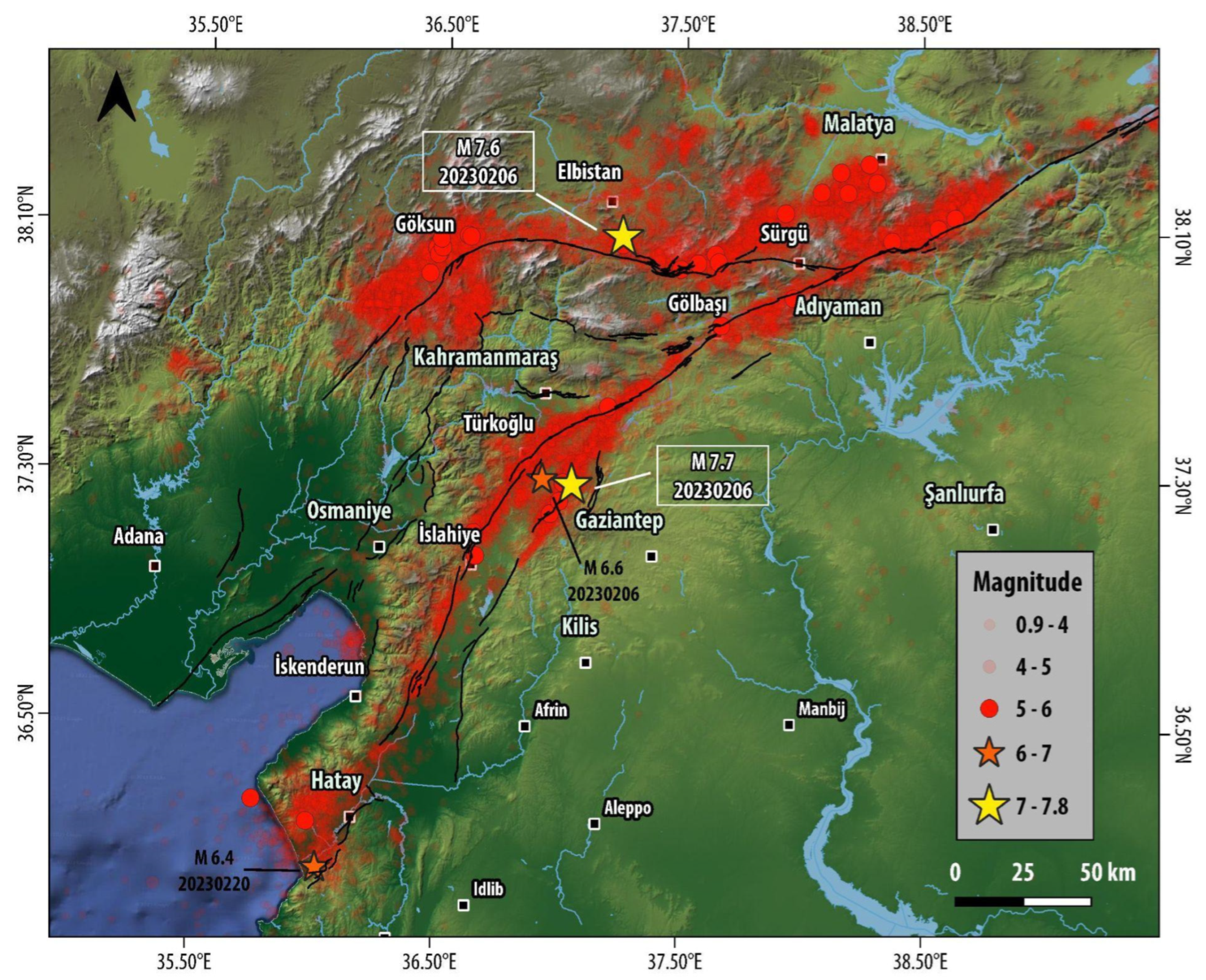
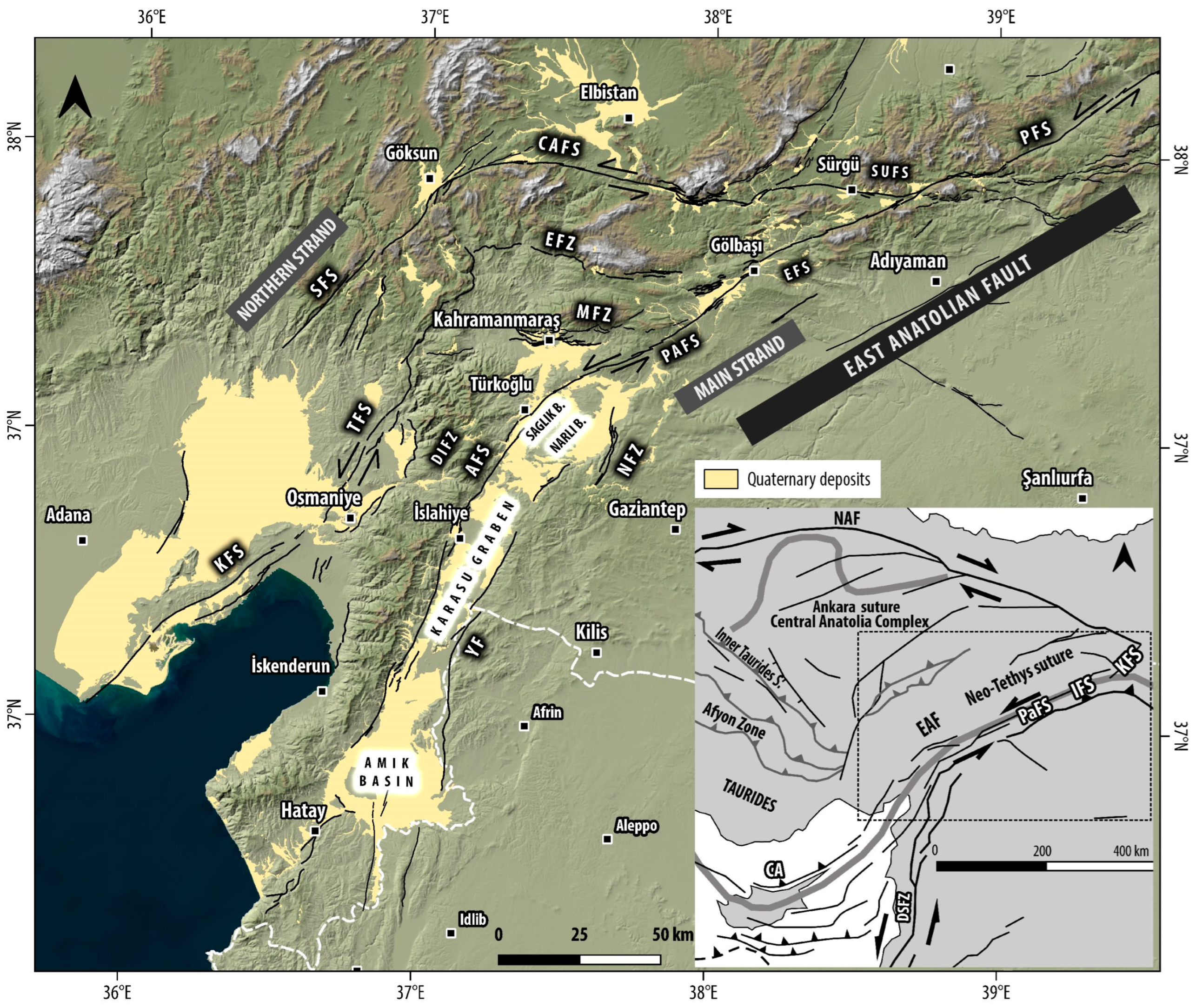

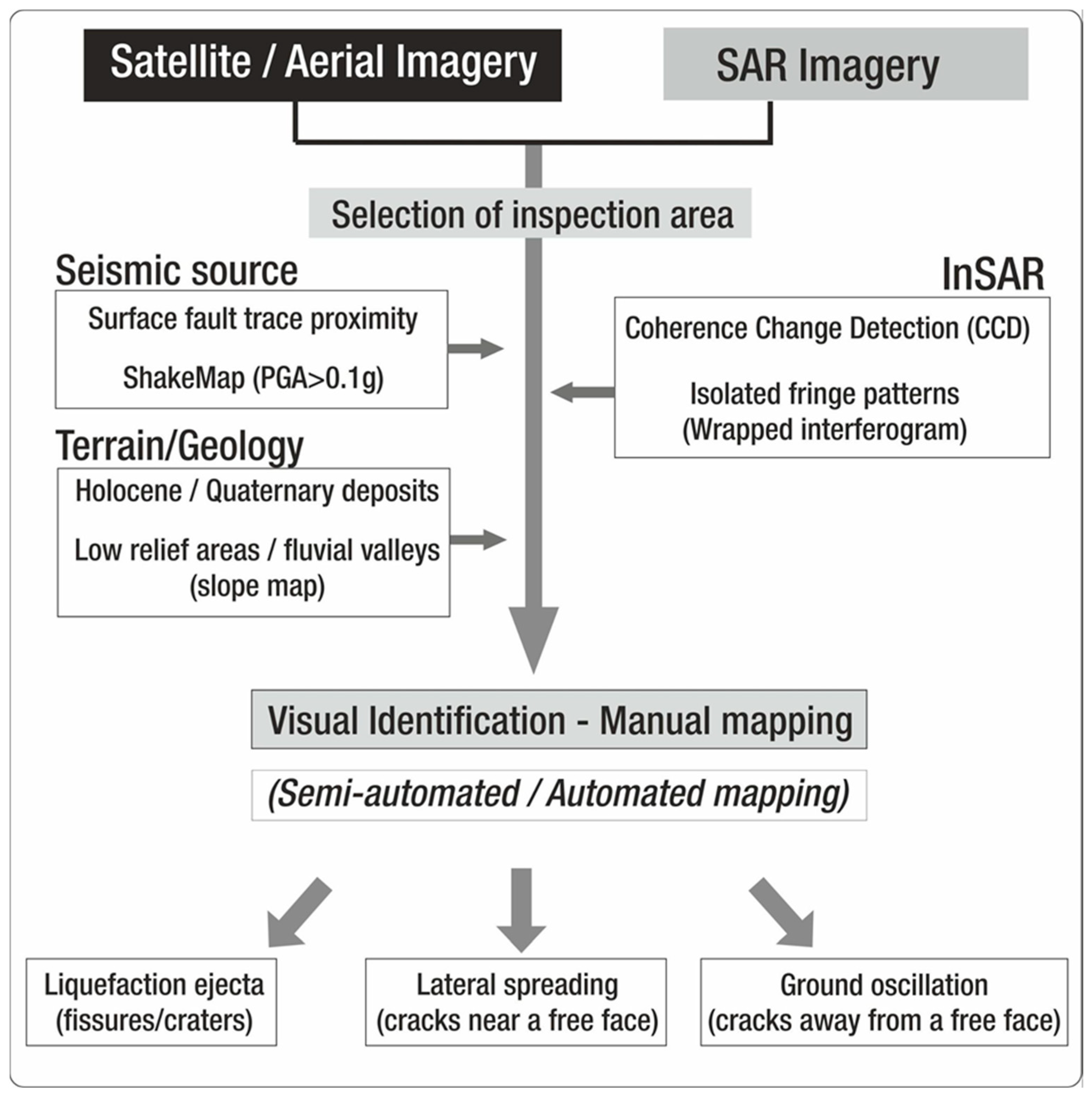
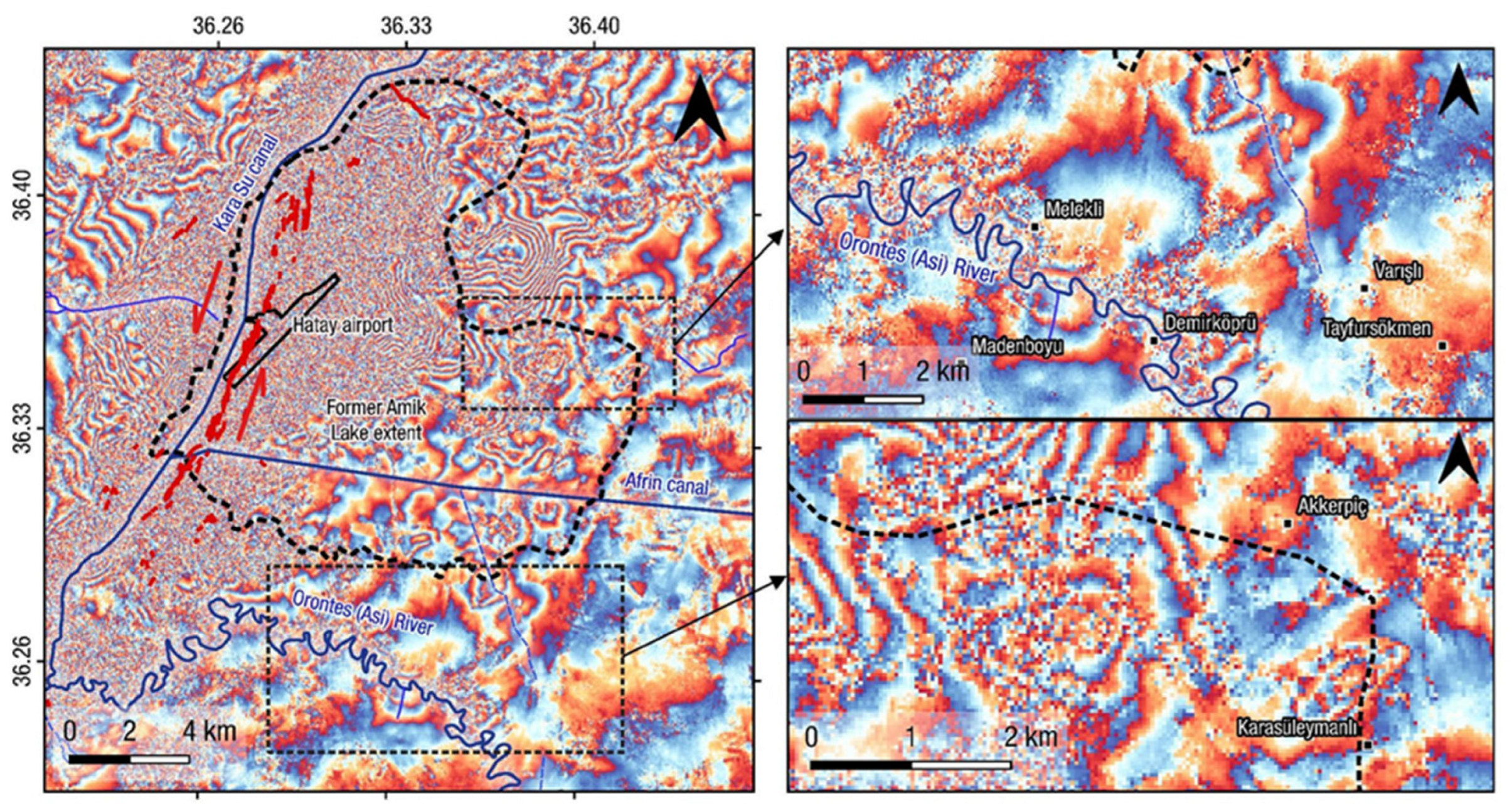
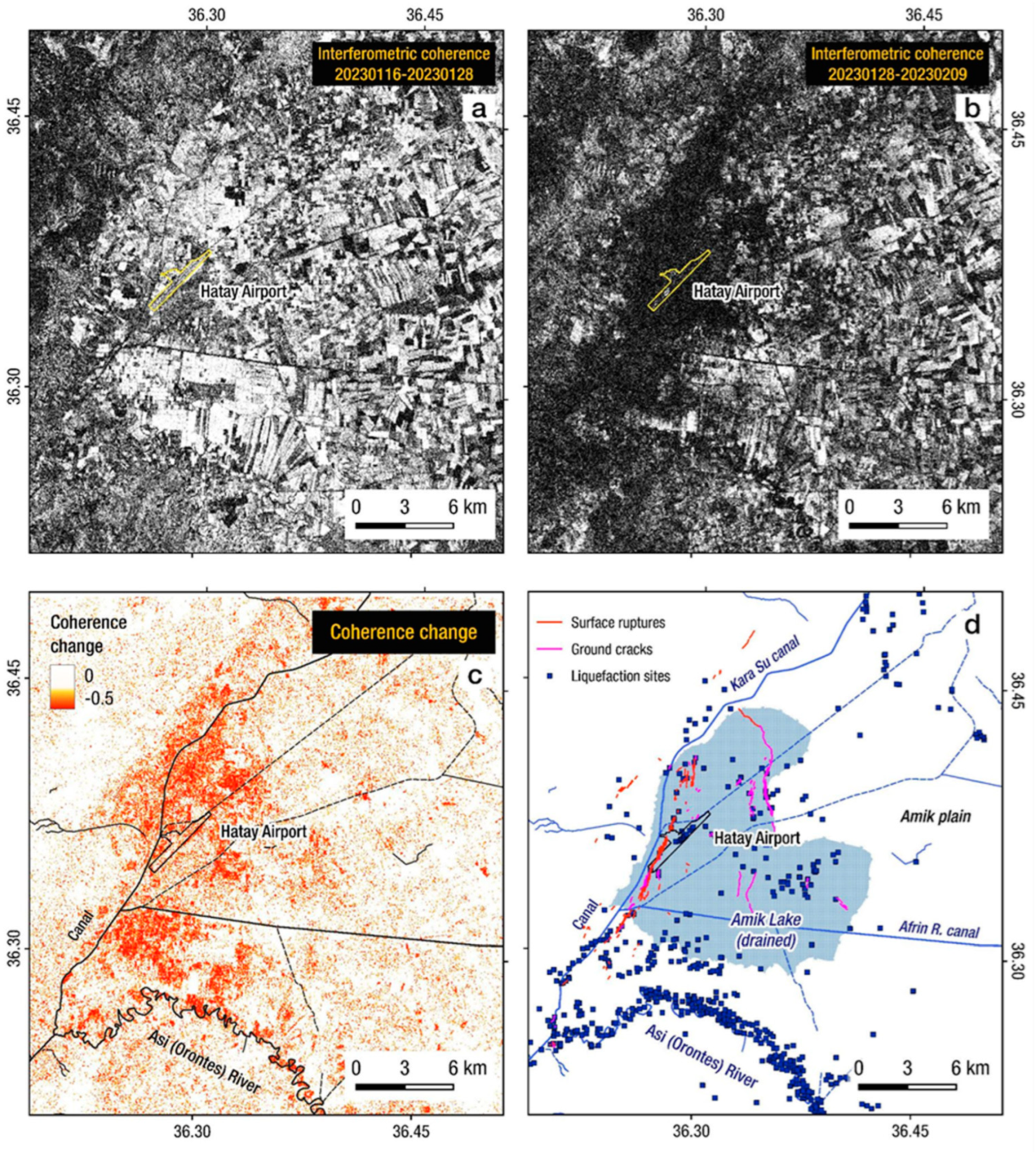
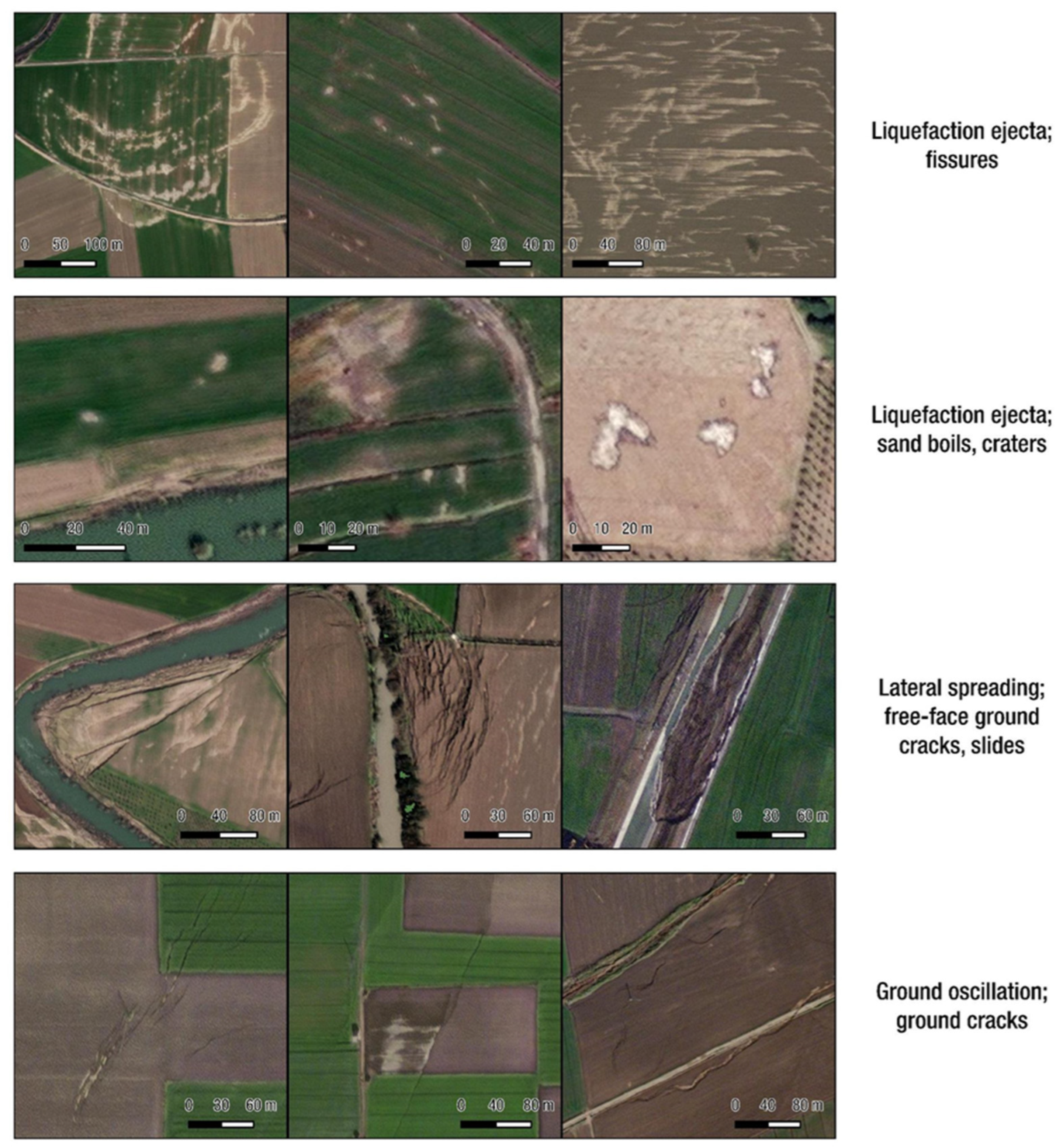

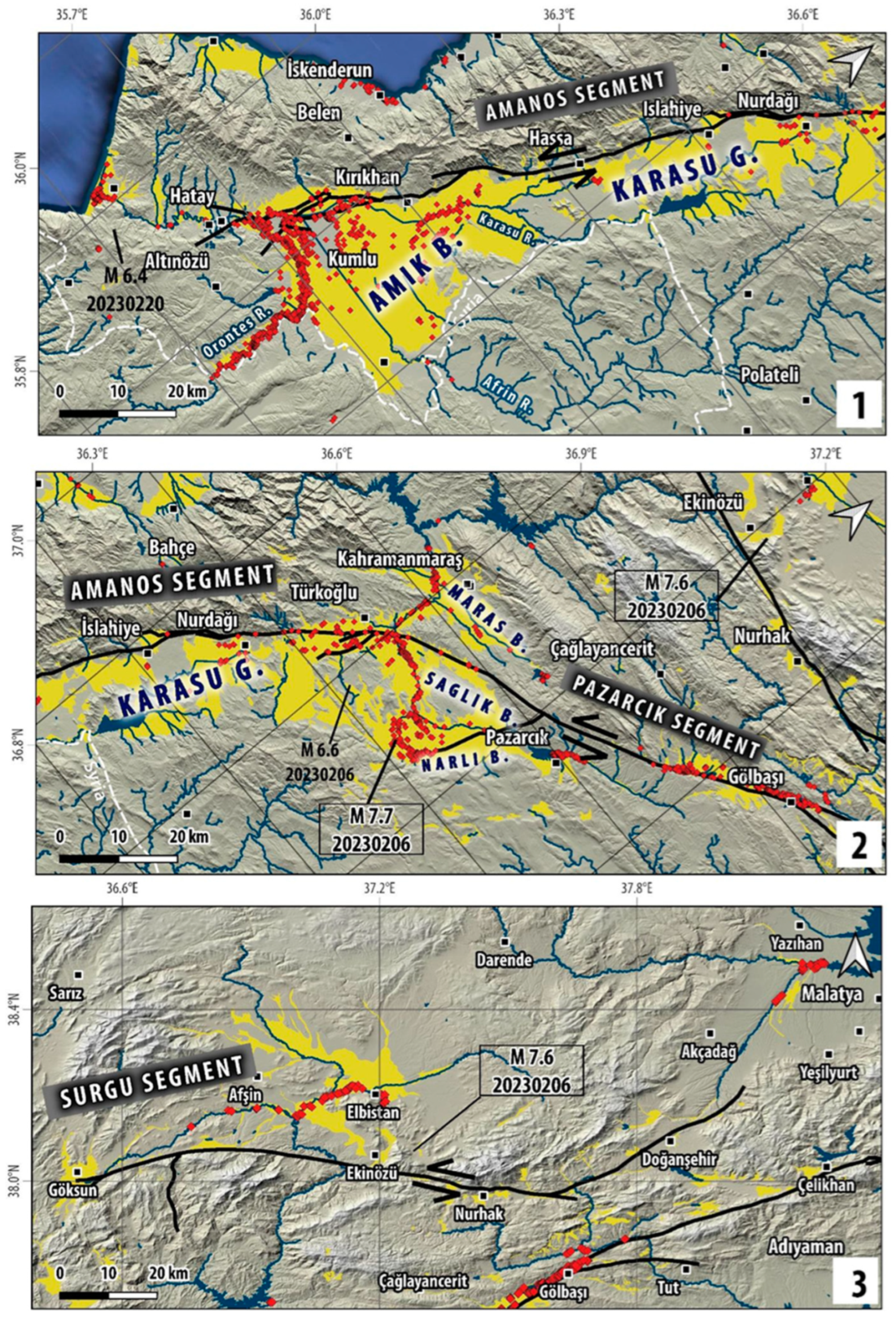
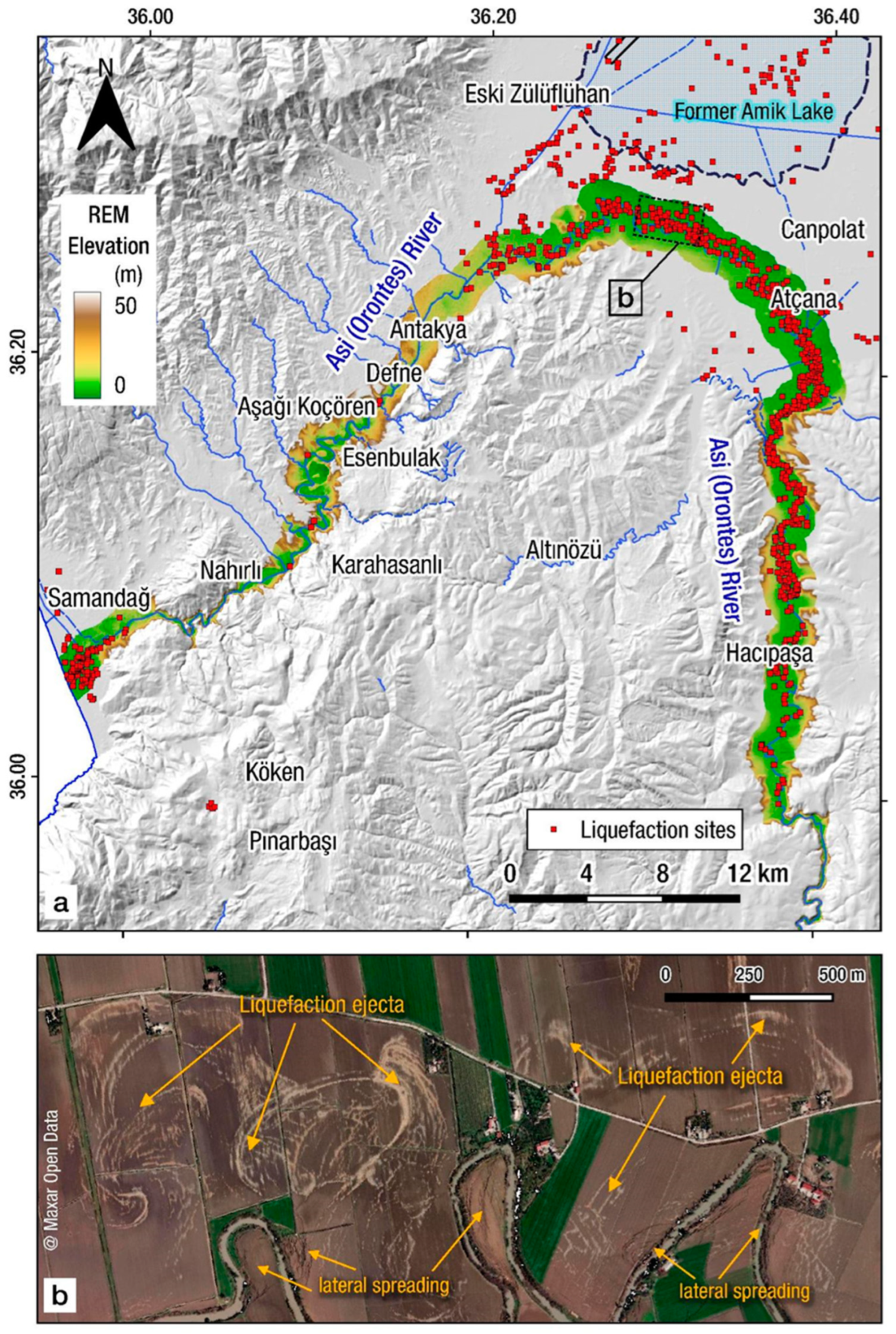
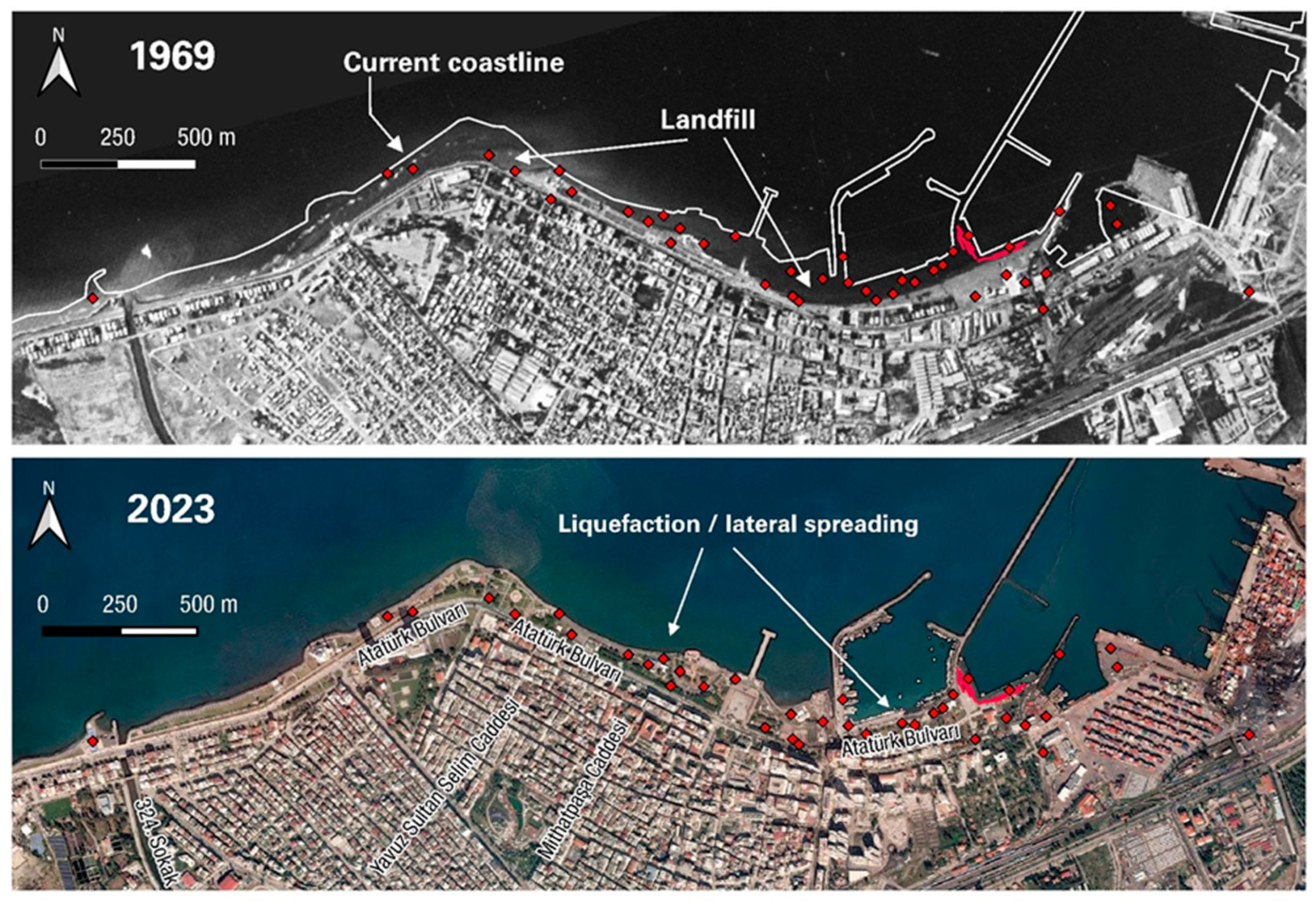

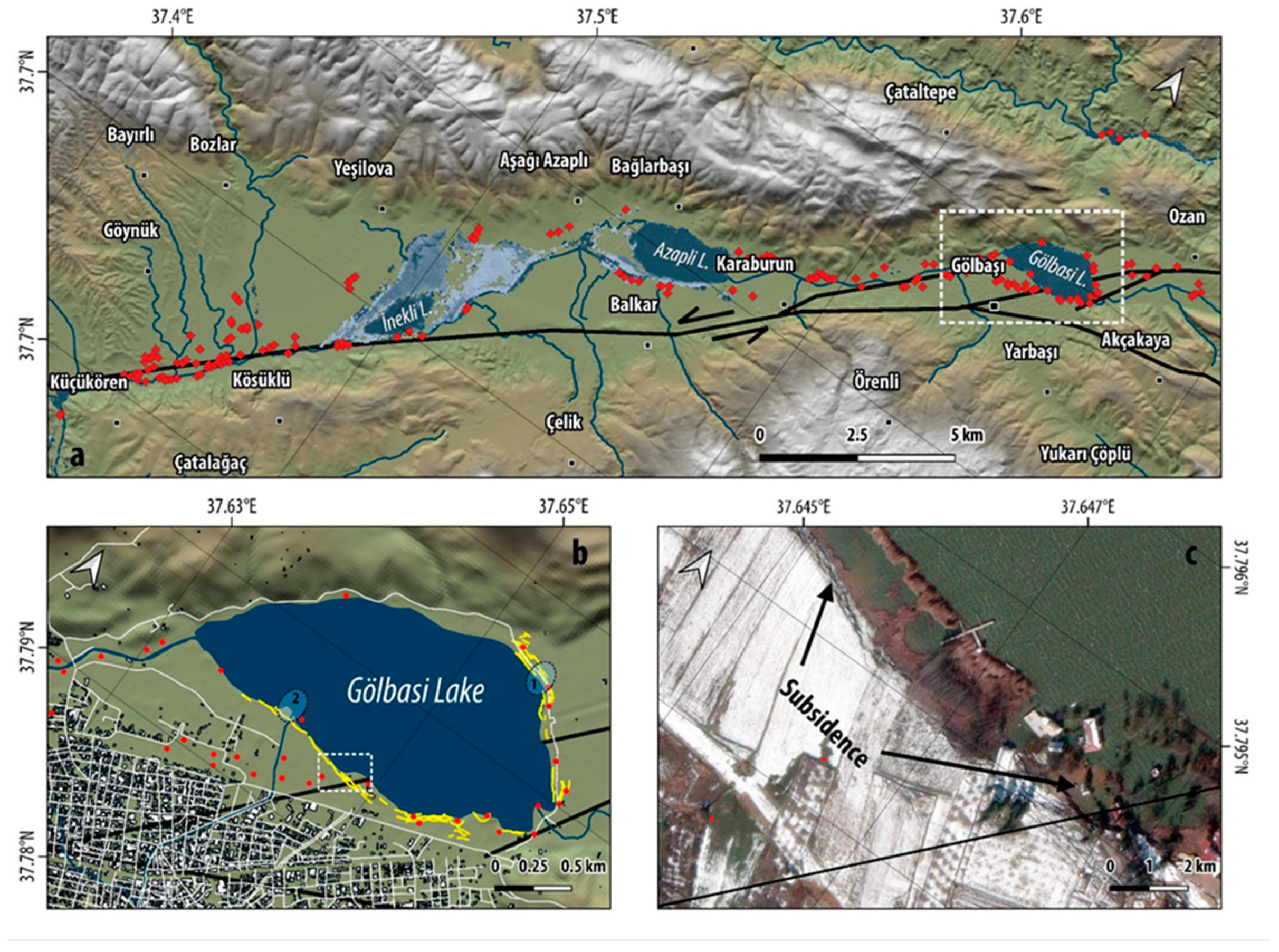
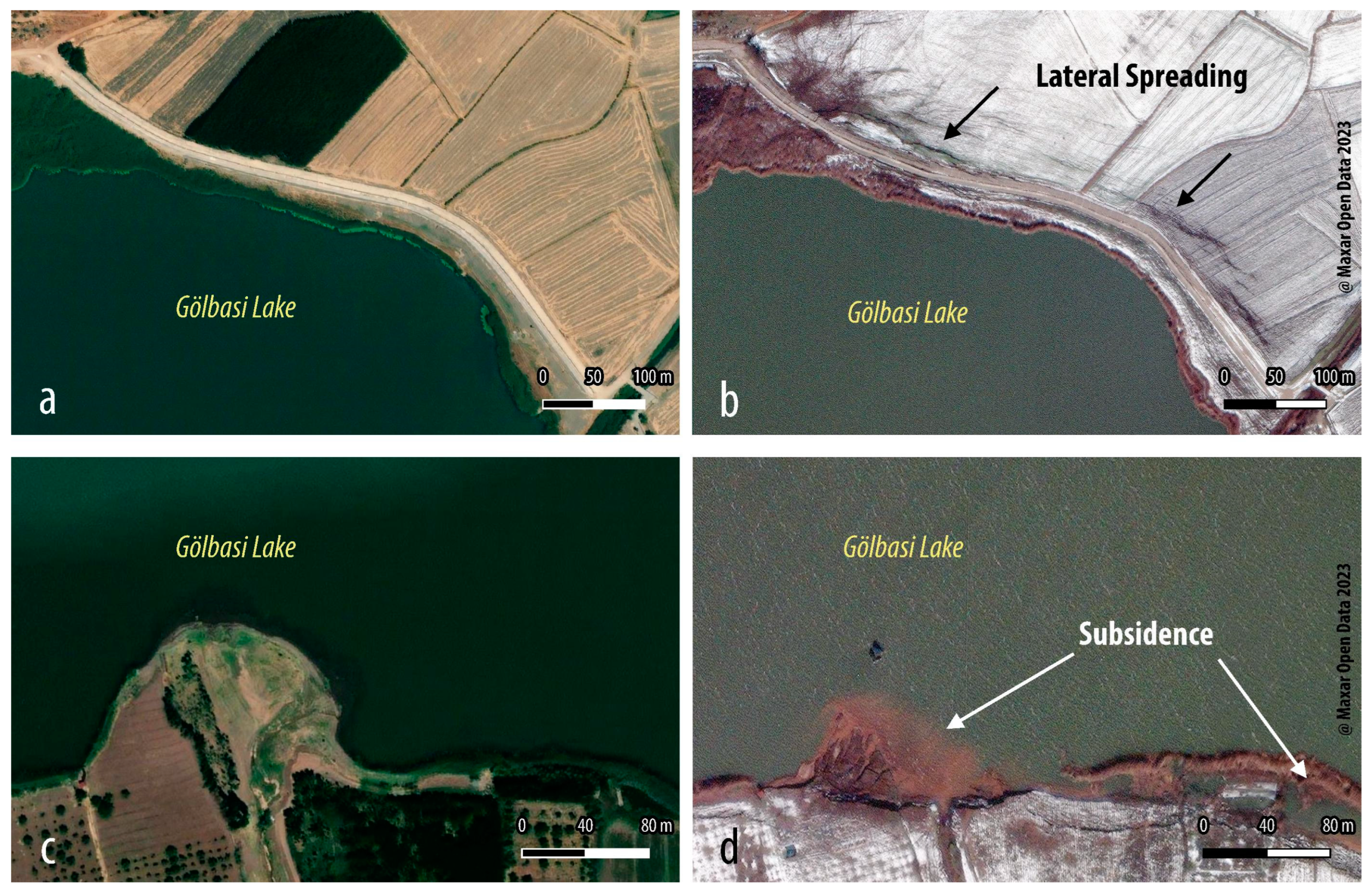
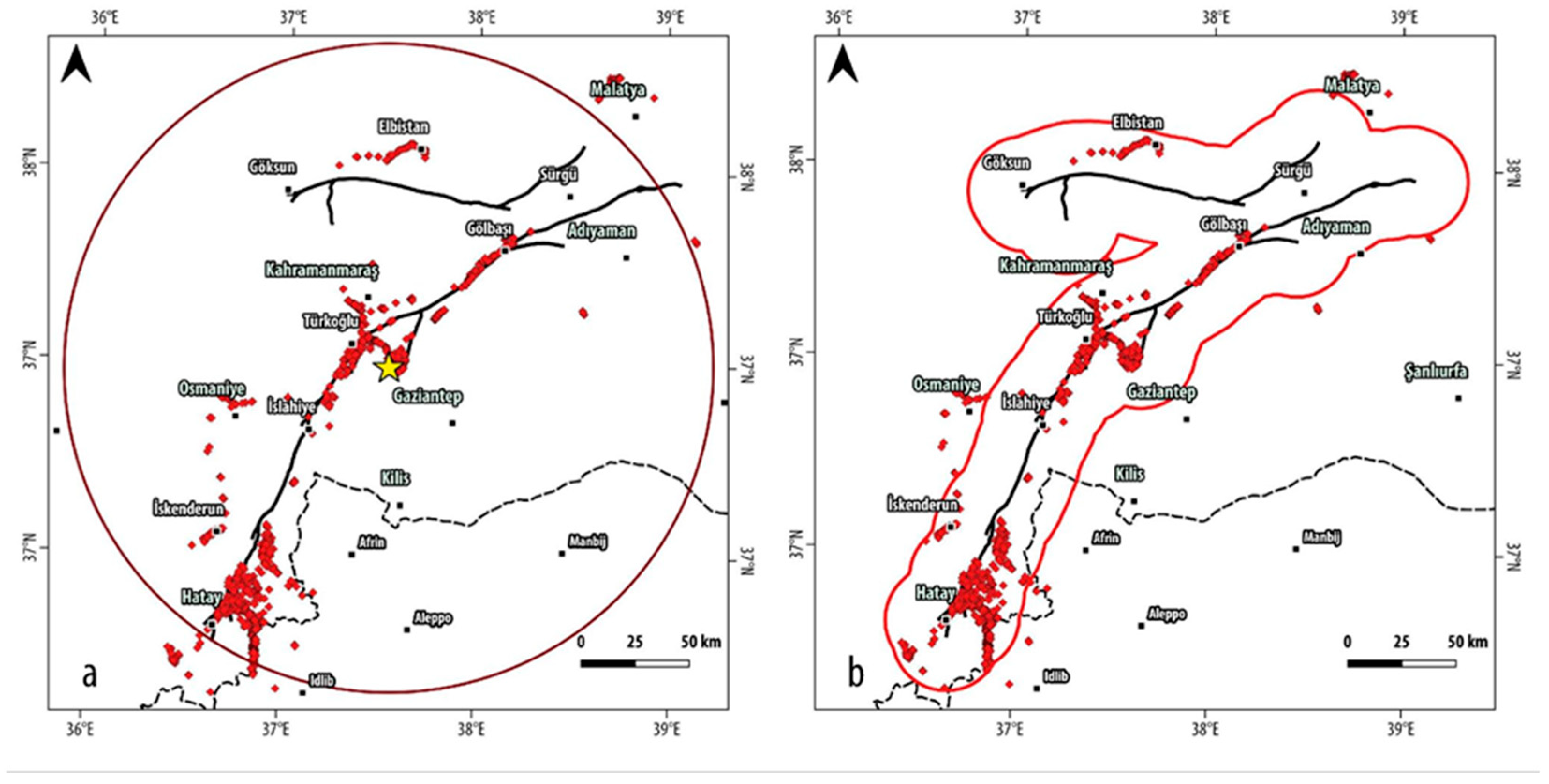

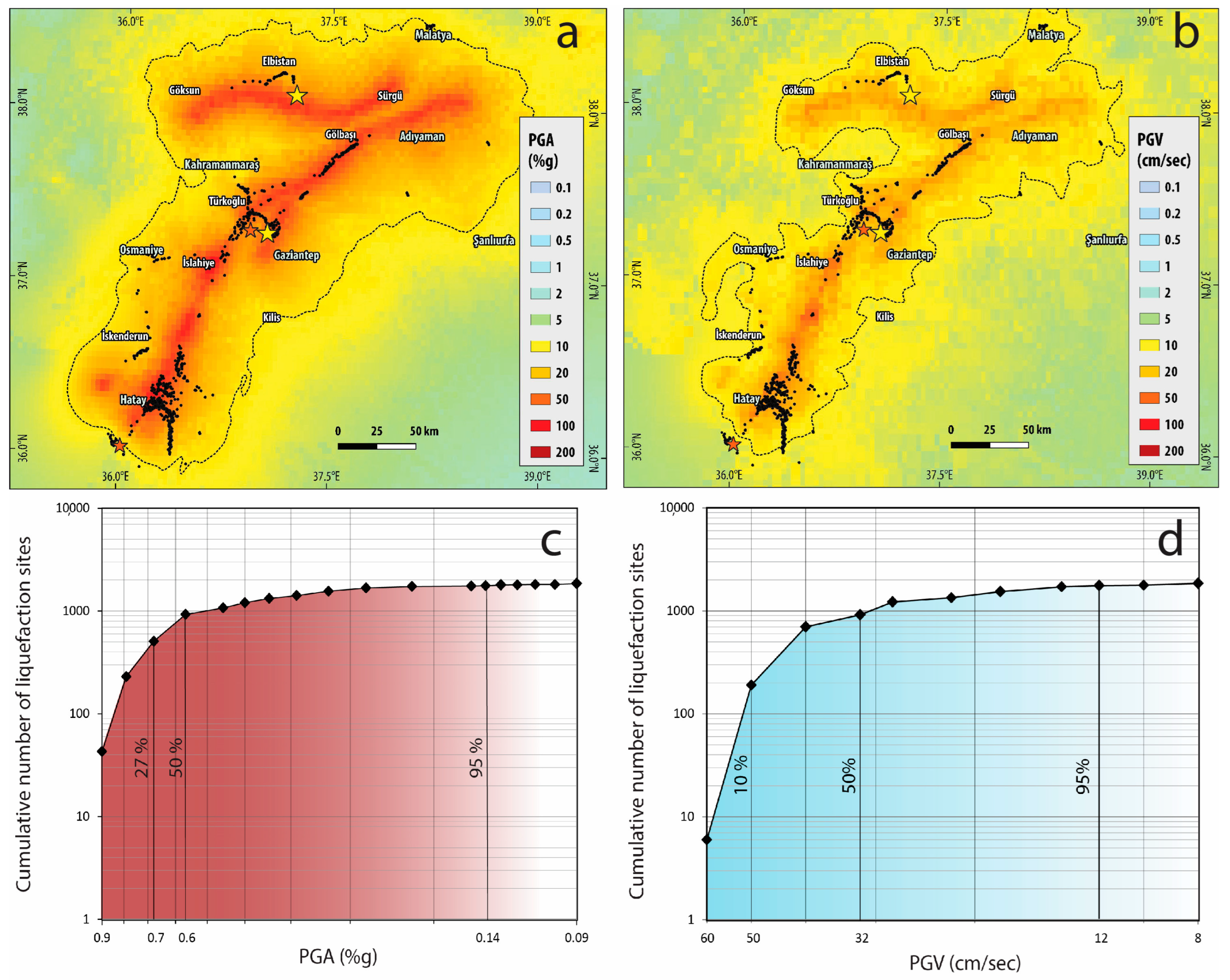
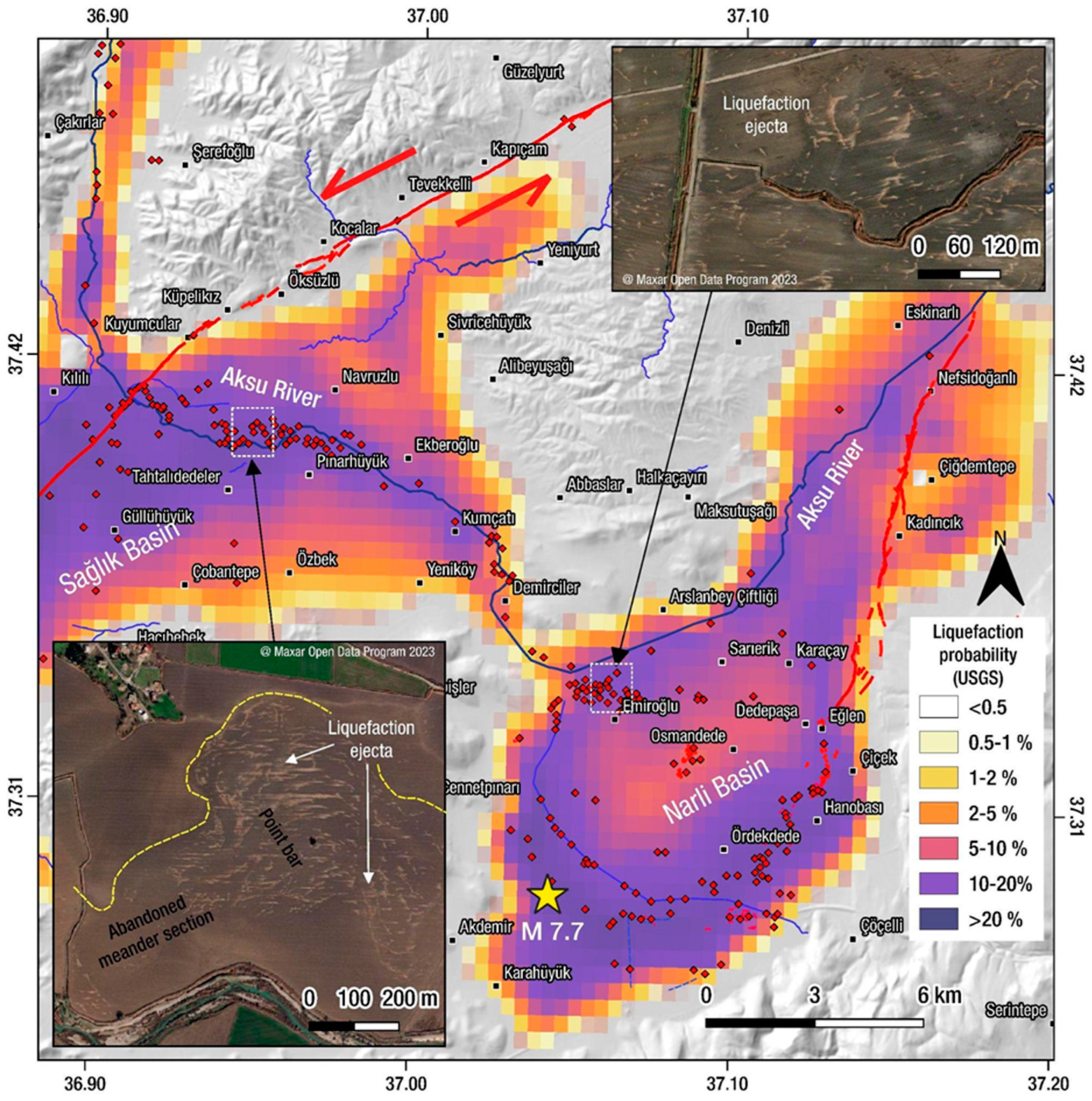
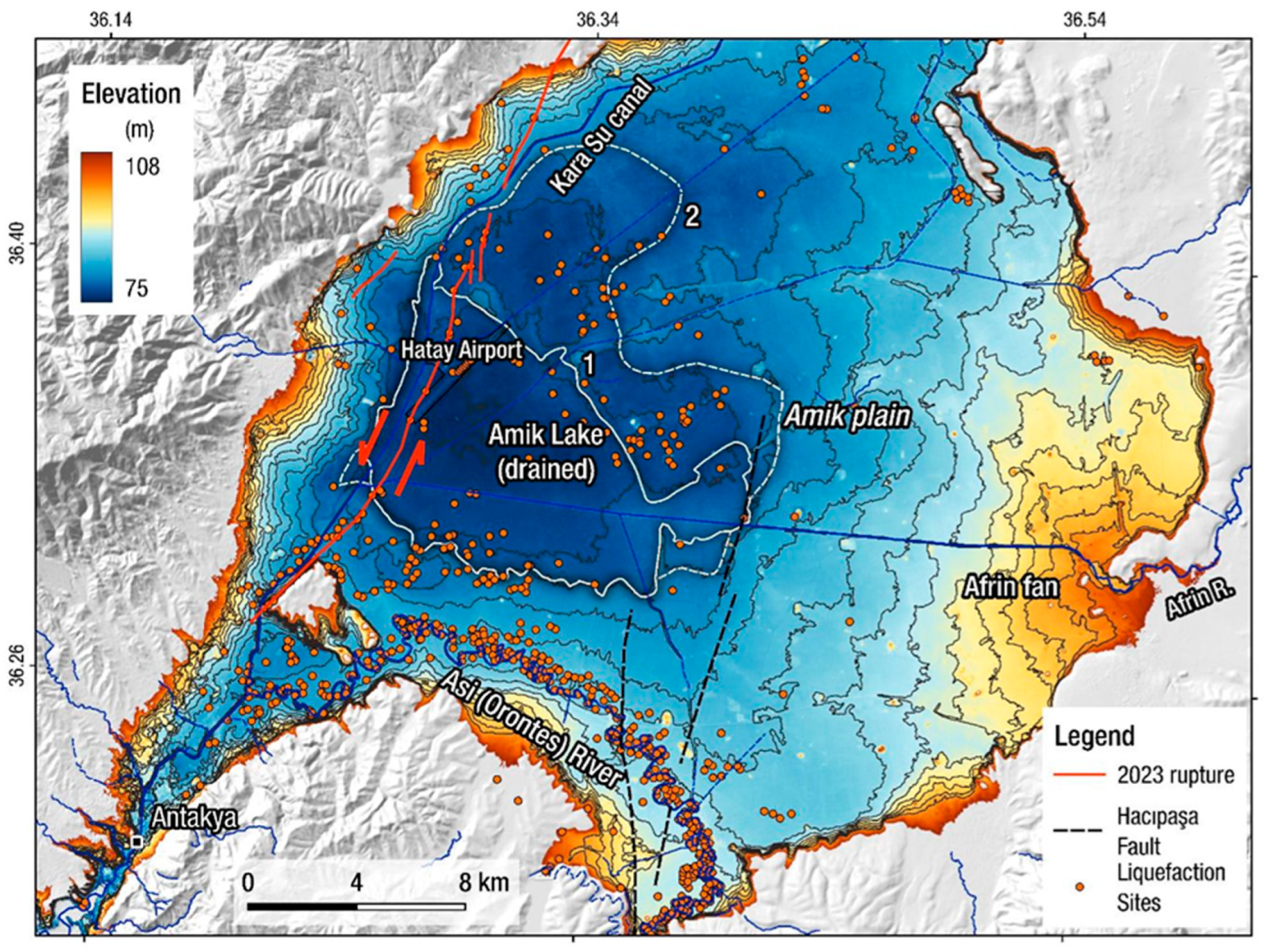
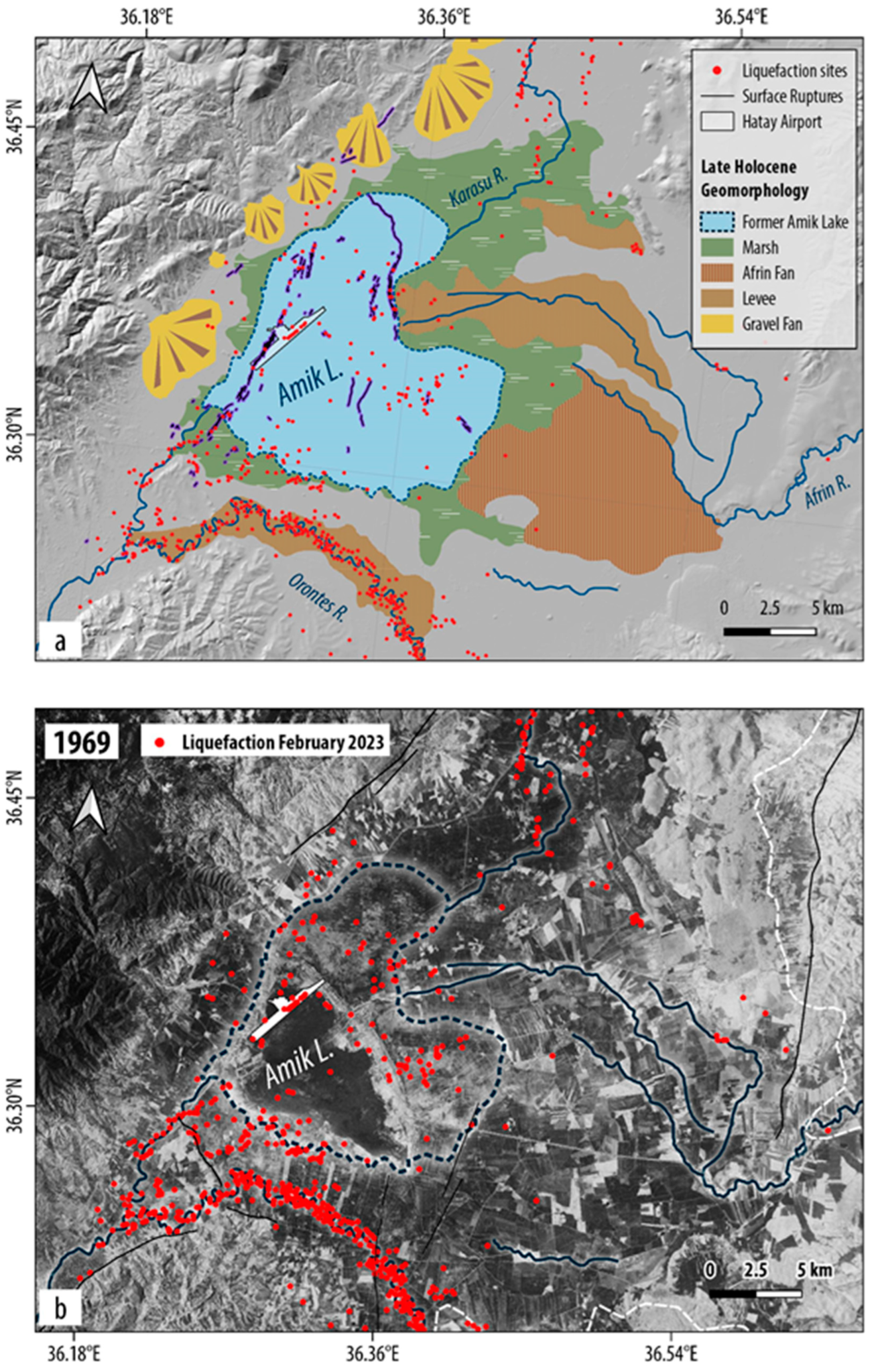

Disclaimer/Publisher’s Note: The statements, opinions and data contained in all publications are solely those of the individual author(s) and contributor(s) and not of MDPI and/or the editor(s). MDPI and/or the editor(s) disclaim responsibility for any injury to people or property resulting from any ideas, methods, instructions or products referred to in the content. |
© 2023 by the authors. Licensee MDPI, Basel, Switzerland. This article is an open access article distributed under the terms and conditions of the Creative Commons Attribution (CC BY) license (https://creativecommons.org/licenses/by/4.0/).
Share and Cite
Taftsoglou, M.; Valkaniotis, S.; Papathanassiou, G.; Karantanellis, E. Satellite Imagery for Rapid Detection of Liquefaction Surface Manifestations: The Case Study of Türkiye–Syria 2023 Earthquakes. Remote Sens. 2023, 15, 4190. https://doi.org/10.3390/rs15174190
Taftsoglou M, Valkaniotis S, Papathanassiou G, Karantanellis E. Satellite Imagery for Rapid Detection of Liquefaction Surface Manifestations: The Case Study of Türkiye–Syria 2023 Earthquakes. Remote Sensing. 2023; 15(17):4190. https://doi.org/10.3390/rs15174190
Chicago/Turabian StyleTaftsoglou, Maria, Sotiris Valkaniotis, George Papathanassiou, and Efstratios Karantanellis. 2023. "Satellite Imagery for Rapid Detection of Liquefaction Surface Manifestations: The Case Study of Türkiye–Syria 2023 Earthquakes" Remote Sensing 15, no. 17: 4190. https://doi.org/10.3390/rs15174190
APA StyleTaftsoglou, M., Valkaniotis, S., Papathanassiou, G., & Karantanellis, E. (2023). Satellite Imagery for Rapid Detection of Liquefaction Surface Manifestations: The Case Study of Türkiye–Syria 2023 Earthquakes. Remote Sensing, 15(17), 4190. https://doi.org/10.3390/rs15174190







